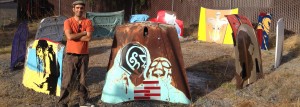When Carlos de Villasante’s stepdaughter tells new friends where she lives, she’s learned to stop saying “the corner of Baker and Bodega.” Now, he reported, she says, “Where the car hoods are.”
If you haven’t driven down Bodega Avenue lately, that reference may be puzzling so allow us to explain.
De Villasante, an associate professor of painting at Sonoma State University, bought a house in Petaluma this spring. He also bought the tiny triangle of land next to it, at the Baker-Bodega corner. “I had to take things out of storage when I moved,” he said, and with a mortgage to pay, couldn’t afford to re-store his painted car hoods. So he did the only logical thing – he created public art.
 He began by putting one hood in his yard. “I was happy with the way it engaged the exterior space and passersby. It seemed funny that I live on Bodega Avenue which in Spanish means warehouse, yet I was storing my art elsewhere. So the solo hood became a circle.
He began by putting one hood in his yard. “I was happy with the way it engaged the exterior space and passersby. It seemed funny that I live on Bodega Avenue which in Spanish means warehouse, yet I was storing my art elsewhere. So the solo hood became a circle.
One might ask, why car hoods? De Villasante, 42, grew up, he said, partly in Boston and partly in Mexico City. He was fascinated by the archaeological ruins of Mexico. “I’d have birthday parties there.”
Car hoods are, he went on, American ruins. “And this site reminds me of those types of ruins. This is an archaeological ruin I made myself from an empty lot.” Although he didn’t realize it at the time, it’s also an unintended salute to Petaluma history – someone showed him a photo of the corner in 1942, when it housed Milt’s Texaco gas station.
De Villasante is a fan of outside art. “I lived in Memphis for a while, and a number of people there put up art in their yards – to share.”
The attention the hoods – he’s dubbed the site Hoodhenge – are getting pleases him. “There’s no explanation,” he said, “there’s all this traffic and – it’s just – here.” He enjoys watching the astonished, mostly delighted reactions of people who walk by.
“It’s a way to connect, to say ‘Hi.’ In the past, when I’ve moved into a new town, I’ve invited people over for dinner but Petaluma’s a little too large. And it’s a good way to share art with the community.
I’ve always wanted to share my work with a broader community than just gallery connoisseurs. I’ve only done so through public murals, all of which were done on the opposite coast.”
Each hood is salvaged from a junkyard, each has “a certain history and damage.” He chooses them for their shapes, and their scars. Most are Honda and Mercedes hoods, but there’s a sturdy 1951 Buick and a small Volkswagen Bug. He’s added mirrors and stickers in addition to painting them and, in some cases, has allowed rusted portions to remain. Some of his metal canvases include characters – he’s featured on a white hood; other hoods feature artists’ models. “The images are all contemplative,” he said. “The hoods tell me what they want.”
While he’s a painting teacher, “this is much more like sculpture.” That pleases him, he said, because he suggests his students try new directions, and find that suggestion inspires him as well.”
He became a teacher, he said with a laugh, “because it paid more than waiting tables and was less hours. But when I quit, I found I missed teaching.”
He began the hoods series in 2005, but completed most of them in 2011 and 2012.
De Villasante doesn’t know what the final use of the lot will be. Perhaps he’ll put a studio there. Perhaps he’ll open the site to other artists. He’s toyed with the idea of an exhibition space, saying “I like the idea of The Bodega on Bodega.”
Right now, though, it’s a whimsical triangle that causes double takes, chuckles and admiration. “I deal with it as a site that’s been forgotten,” de Villasante said, referring to those ruins he felt so close to. “I’m not cleaning it up,” and he kicked at gravel and weeds. “I’m keeping it in a state of blissful forgottenness.
“ I love watering my plants or sitting on my porch while someone ‘discovers’ my contemporary archeological site, as they decide what it is doing there or decoding what it means.”
